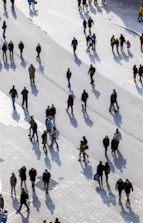
Architects
have known about the importance of human scaling for quite some time
now.
They’ve realized that an environment of nothing but vast monumental
structures—think North Korean military parade routes—makes people feel
individually
inconsequential (which may actually have been intentional on the part
of the
North Korean government). To counter this oppressive
gigantism of scale,
it's necessary to intersperse a big public plaza with trees
and other
foliage, small shops and restaurants, and interesting nooks and
crannies, in
order for people to feel at ease in them.
City planners all tend to know about these principles, but for various reasons, have often neglected them, typically with unnecessarily alienating results.
There’s a good example of the difference between gigantism and a more appropriate scale near the community where I live.
In one area, there’s a pleasant street full of little stores. They’re definitely “stores” rather than “shops,” in the sense that they’re hardly toney or trendy boutiques. One houses a tax preparation service; another sells used vacuum cleaners. The overall feel of the neighborhood is delightful, though. Trees dapple the sunlight on the sidewalk, and there’s always an interesting variety of window displays to look at as you walk by.
In another area stands a new Walmart. Taking a walk for pleasure in this area would be unimaginable. Most of the area is just a stark, broiling, glare-filled parking lot. What isn’t parking lot is a blank, windowless, impervious mass. You could no more window shop this Walmart than you could casually glance into Fort Knox or a federal penitentiary. And what would anyone be doing walking around there in the first place? It’s unpleasant enough to approach in a car.
The difference in the two neighborhoods goes beyond mere visual impressions, and gets into the underlying social and economic structure. On the street of little stores, it’s plausible to imagine myself opening up some kind of little business of my own someday. This means that I can entertain the possibility of being an active and rooted participant in this environment, rather than just a transient spectator.
I could not in my wildest imaginings picture myself opening up a store the size of a Walmart—or any of its comparably gargantuan neighbors. When I go to the area where these mega-marts are encamped, I know that my only possible role there is as a consumer.


